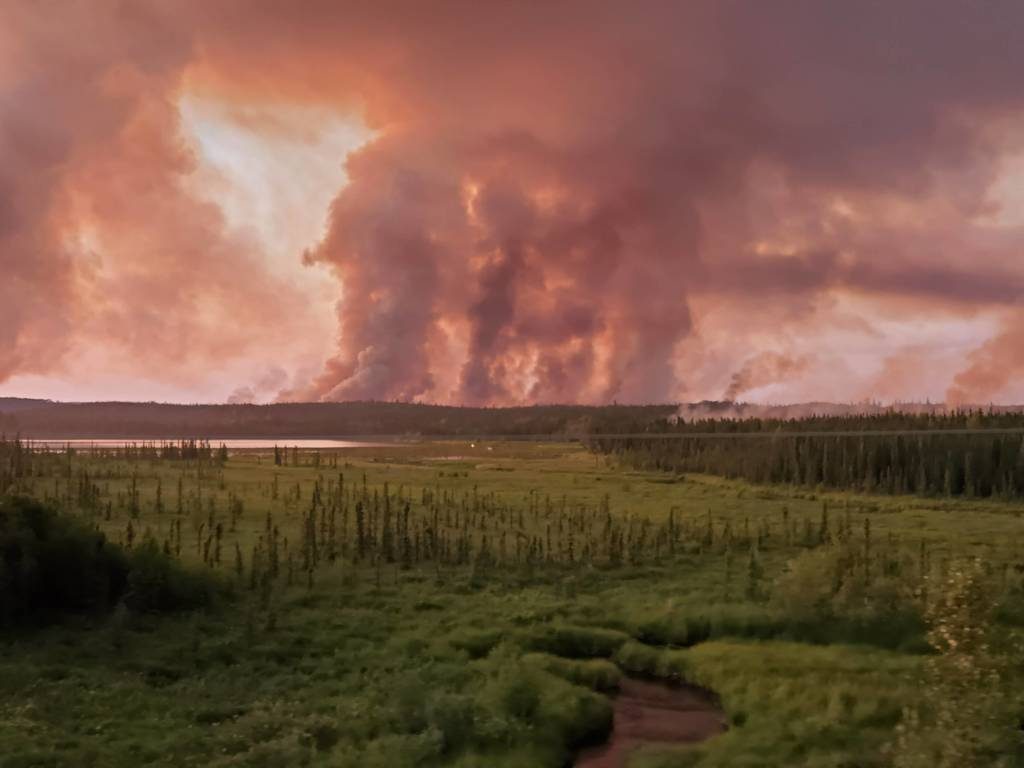Record-smashing heat has scorched Alaska over the past few days, and even worse heat is in store for the week ahead.
On Saturday, downtown Juneau, Alaska’s capital city, hit 83 degrees, breaking a record that had stood for 110 years.

India and Europe aren’t the only parts of the world that’s been roasting and burning of late. So is Alaska.
Record-smashing heat has scorched Alaska over the past few days, and even worse heat is in store for the week ahead.
On Saturday, downtown Juneau, Alaska’s capital city, hit 83 degrees, breaking a record that had stood for 110 years.
The heatwave in #Europe is historically noteworthy. But from a temperature anomaly perspective – the difference from normal – we're also seeing similarly unusual levels of warmth in #Alaska right now. pic.twitter.com/bE7OgPMOTC
— Steve Bowen (@SteveBowenWx) June 28, 2019
The heat has also exacerbated a wildfire near Anchorage that’s brought extremely smoky skies to the city. Late Sunday, people walked through midtown Anchorage covering their faces with their shirts, the Anchorage Daily News reported.
Smoke from the blaze has been covering the Anchorage area since early Thursday, AccuWeather said.
Lightning in Alaska sparked wildfires in June that continue to blaze today. #SuomiNPP’s VIIRS instrument caught 2 of the largest in this image: The Swan Lake Fire and the Hess Creek Fire. More here: https://t.co/mc1dxToz8N pic.twitter.com/MMJFaZ37vE
— Joint Polar Satellite System (JPSS) (@JPSSProgram) July 1, 2019
“Persons with respiratory problems may have difficulty breathing when outside,” the National Weather Service warned in a “dense smoke advisory” issued for the eastern Kenai Peninsula, not far from Anchorage.
The blaze, known as the Swan Lake fire, was 106 square miles in size and 17% contained as of Sunday night.
Unprecedented hot temperatures
Saturday was only the fifth day since 1952 that Anchorage, Juneau and Fairbanks were all 81 degrees or warmer, according to Alaska-based climatologist Brian Brettschneider.
The temperature in Anchorage on Sunday soared to 82 degrees, the city’s highest reading in three years, the weather service said.
While we heat up in Texas, a HEAT WAVE has been baking Alaska! Highs on the 4th of July will be in the 80s many places with high humidity. Even the north coast will see temps in the 60s! (Admittedly nice for the Metroplex!) pic.twitter.com/OYXjo6S4SD
— Dan Henry (@Fox4Weather) July 2, 2019
People were advised by the weather service to “be sure to stay hydrated and drink plenty of water – don’t wait until you are thirsty!“
In central Alaska, residents of Fairbanks had their own wildfire to deal with: Emergency officials issued evacuation warnings Sunday to some residents there as the Shovel Creek wildfire burned nearby.
Without air-conditioning, temperatures in homes skyrocketed to levels not usually found in Alaska: “With fans running and the doors/windows open, (I) was able to get the house temperature below 75 degrees F for the first time in days,” Brettschneider said Sunday.
#RT @NWSSanDiego: Thinking of vacation plans? Check out the current temperatures across Alaska! Yes, those are TEMPERATURES folks! ? Time for a trip to the Alaskan wilderness! #akwx #heatwave pic.twitter.com/Un83E2HSUv
— Warning Watch | San Diego East County (@SD_Stuff) June 29, 2019
Ocean flooding?
Along the state’s northern coast, melting sea ice is the main worry because of extremely warm ocean temperatures. Though not tied into this specific heat wave in southern Alaska, unusual springtime heat along the north coast melted sea ice along northern Alaska. The ice disappeared far earlier than normal this spring, alarming coastal residents who rely on wildlife and fish.
The early melting has been “crazy,” said Janet Mitchell of Kivalina.
Rick Thoman, a climatologist with the University of Alaska Fairbanks, posted on social media last week that the northern Bering and southern Chukchi seas are “baking.”
Right now in Alaska, the sea ice is at a record low for this time of year and 38 large wildfires have burned 418,000 acres.
— Eric Holthaus (@EricHolthaus) July 2, 2019
This week is supposed to be the hottest ever in Anchorage, with high temps reaching 85°F (29.4°C) https://t.co/gTuMBixOET
Sea surface temperatures last week there were as high as 9 degrees above the 1981-2010 average.
The last five years have produced the warmest sea-surface temperatures on record in the region, contributing to record low sea-ice levels.
Next heat wave ahead even worse
Meanwhile, in southern Alaska, the next heat wave will be worse than the one over the weekend:
“It’s forecast to be stronger and hotter than the one we just had,” Patrick Doll, a meteorologist with the weather service in Anchorage, told the Daily News. “Think of what we’ve been experiencing and tack on 2-4 degrees.”
Southern Alaska's ongoing #heatwave is expected to intensify significantly over coming week. Strength of high-pressure ridge at mid-levels of atmosphere may exceed all-time records over much of state. Surface temperatures may also reach all-time records in southern areas. #AKwx pic.twitter.com/BnTSqYuliR
— Daniel Swain (@Weather_West) July 2, 2019
Brettschneider tweeted that “we may approach all-time records in places.” The state’s all-time record high temperature of 100 degrees – which is not forecast to be be broken – was set in Fort Yukon in June 1915.
Alaska and Hawaii are the only two states where the state’s all-time high is “only” 100 degrees.
After India followed Europe and now Alaska, USA. Where and when will those heat waves stop?












